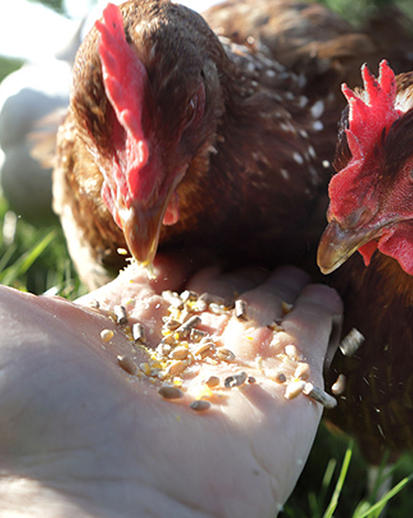Trends
Our Nutrition business addresses two significant trends: in animal nutrition and health, the urgent need to enable the sustainable production of animal protein, and in human nutrition and health, the growing demand for (personalized) health solutions.
Enabling the sustainable production of animal protein
The world’s population is projected to reach 9.7 billion by 20501. At the same time, demand for healthier, balanced, and more nutrient-dense diets is increasing — driven not only by the growth of the world’s population but also by changing health awareness and consumer expectations. Even with calls for a more balanced consumption of animal protein and replacement by vegetable alternatives, demand is still likely to grow as many populations need to raise their animal protein intake to attain a level of balanced, healthy nutrition. Enabling sustainable animal production is therefore of paramount importance.
Animal-based proteins are highly nutritious and form a key part of a balanced, healthy diet. Their consumption is also central to many cultures, and animal-source foods and other animal-source products play an important socio-economic role in those cultures. However, livestock production comes at a cost. This cost is increasingly evident. Rising demand for animal protein is driving up greenhouse gas emissions and piling pressure on natural resources. In some cases, this pressure has already transgressed accepted planetary boundaries. The planetary boundaries include the Earth’s limits of greenhouse gas (GHG) emissions, biochemical flows, water quality and quantity, land use, and biodiversity. The agri-food sector is one of the major contributors to global GHG emissions, and almost a third of wild fisheries are overexploited. The sustainability of animal protein production is now front and center in the minds of many, and calls for change from the value chain, policy makers and associated stakeholders are widespread.
Our solutions
We strongly believe in sustainable animal farming and food systems, and that the livestock industry can transform itself from within to deliver solutions to the challenges facing society and the animal protein industry. We want to play a key role in this transformation. That is why in Animal Nutrition & Health, we focus on the following six sustainability platforms to support our customer, the livestock value chain and other stakeholders to address the environmental challenges facing our planet:
- Improving the lifetime performance of farm animals
- Making efficient use of natural resources
- Reducing emissions from livestock
- Helping tackle antimicrobial resistance
- Reducing our reliance on marine resources
- Improving the nutritional quality of meat, milk, fish and eggs while reducing food loss and waste
To tackle these challenges, we have an extensive existing portfolio of carotenoids, feed enzymes and vitamin portfolio. For example, our enzymes help animals digest more efficiently and extract more nutritional value from the feed. They therefore still grow well even when consuming less. As a result, fewer natural resources, such as land and water, are needed for animal protein production. We are also rolling out our methane-reducing feed additive for ruminants, Bovaer® and further extending our capabilities in precision nutrition, building on the foundations of our globally recognized Optimum Vitamin Nutrition™ (OVN™) concept. More information on our solutions for sustainable animal farming can be found in this case study.
The growing demand for (personalized) health solutions
Despite the increasing attention being given to the central role of nutrition in supporting immune function and healthy growth and development, the world continues to face a wide range of food-related health issues and challenges. Today, according to the 2020 Global Nutrition Report, “One in every nine people in the world is hungry, and one in every three is overweight or obese. More and more countries experience the double burden of malnutrition, where undernutrition coexists with overweight, obesity and other diet-related non-communicable diseases (NCDs). The trend is clear: progress is too slow to meet the global targets. Not one country is on course to meet all ten of the 2025 global nutrition targets and just 8 of 194 countries are on track to meet four targets. Almost a quarter of all children under 5 years of age are stunted. At the same time, overweight and obesity are increasing rapidly in nearly every country in the world, with no signs of slowing.”
While many low- and middle-income countries are still grappling with fundamental problems of food and nutrition security, the world’s food systems as a whole are coming under growing scrutiny. Food poverty exists in even the richest countries of the world, as the continuing prevalence of food banks attests. Governments, NGOs, academia and the private sector worldwide need to develop evidence-based approaches that will deliver affordable, accessible and nutritious diets for all people in all countries at all stages of the life cycle.
The crucial role of nutrition in supporting immune function was thrown into sharper perspective than ever during the COVID-19 pandemic, accelerating the existing trend toward personalized health and nutrition. The pandemic simultaneously accelerated the use of digital communications in delivering these solutions, as consumers increasingly sought to boost their immune systems with the aid of fortified foods and dietary supplements.
There is a growing demand for plant-based alternatives alongside traditional meat and dairy products, as consumers search for foods that deliver an authentic eating experience without compromising on taste and texture. Whether for personal, health or sustainability reasons, or from plain curiosity, more and more people are adding plant-based options to their food choices and are adopting flexitarian, vegetarian, or vegan diets. At the same time, the importance of a quality nutritional profile is attracting increasing recognition.
There is also growing interest worldwide in personalized nutrition — science-based, data-driven nutritional solutions tailored to consumers’ specific health goals and needs. Differences in age, genotype and health status mean that individuals can react in very different ways to the same foods. Personalized nutrition allows individuals to make dietary choices tailored to their specific needs, reducing their exposure to a wide range of non-communicable diseases and helping to lower healthcare costs.
Our solutions
We have expanded our existing portfolio of nutritional ingredients (such as food enzymes, nutritional lipids, carotenoids and cultures) through for example our 2020 acquisition of Glycom, the world’s leading supplier of human milk oligosaccharides (HMOs) and our acquisition of capabilities in hydrocolloids between 2017 and 2019. Our offering in probiotics and prebiotics is driven by a mixture of in-house innovation (including partnerships) and targeted acquisitions. We also develop in-house and together with partners our own offerings in the fields of sugar-free sweeteners (EVERSWEET™), skin actives and sun filters.
As a global pioneer in the industrial production of vitamins, we cover the entire range of critical micronutrients, whose efficacy continues to reveal itself in new ways. We have, for example, a new range of Market-Ready Solutions (MRS) to enable our customers to launch new immunity-supporting products in a matter of months. Another example of an immunity-supporting solution is Ampli-D. Fast-evolving evidence suggests an association. More information on how we accelerated the launch of nutritional solutions supporting immunity can be found in this case study. Another example of an immunity-supporting solution is Ampli-D. Fast-evolving evidence suggests an association between vitamin D status and sensitivity to viral infections like COVID-19 incidence and severity. However, it can take up to several months for a person to reach an optimal vitamin D status. Ampli-D helps raise vitamin D levels three to five times faster, compared to vitamin D3.
In the field of meat alternatives, we offer a range of solutions for meat analogs that deliver proteins, authentic meaty taste and create succulent, chewy texture. At the same time, because our yeast extracts unlock full umami flavor, producers can reduce the amount of added salt in their recipes, improving the health appeal. In this case study on meat and dairy alternatives you can find more detail on how we enable tastier, more nutritious plant-based choices for consumers.
1 Source: UN
Scope 1: Direct GHG emissions
Direct GHG emissions occur from sources that are owned or controlled by the company (i.e., emissions from combustion in owned or controlled boilers, furnaces, vehicles, etc.).
Scope 2: Indirect GHG emissions
Indirect GHG emissions relate to the generation of purchased energy (i.e., electricity, heat or cooling) consumed by the company. Purchased energy is defined as energy that is purchased or otherwise brought into the organizational boundary of the company. Scope 2 emissions physically occur at the facility where the energy is generated.
Scope 3: Value chain emissions
Scope 3 emissions are all indirect emissions (not included in scope 2) that occur in the value chain of the reporting company, including both upstream and downstream emissions.
Location-based emissions
Reflects the average GHG emissions intensity of grids on which electricity consumption occurs (using mostly national grid-average emission factor data). Corresponding emission factor: in most cases, the country emission factor.
Market-based emissions
Reflects GHG emissions from electricity supplies that companies have purposely chosen (or their lack of choice) and contracted. Corresponding emission factors:
- Supplier specific emission factor (provided by the supplier)
- Residual emission factor (country-based grid factor, corrected for allocated purchased electricity from renewable resources)







